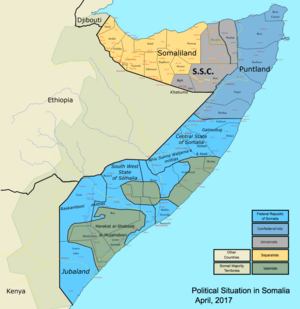 Somalia's states, regions and districts (Photo credit: Wikipedia)
Somalia's states, regions and districts (Photo credit: Wikipedia)
By Abdifatah Shafat
April 4, 2012
The recent conference which was held in England and chaired by the British Prime Minister David Cameron, among other dignitaries, is the latest in a string of efforts to bring back stability to Somalia. Nevertheless, similar consortia of foreign officials, non-governmental organizations, Somali clan leaders and elites, as well as military interventions have been the hallmark of the international community’s reaction to the Somali crises following its descent into civil strife over 21 years ago.
As underscored in the London conference, the stakes couldn’t be higher. The country is still mired in insecurity; the economy is in the wastebasket, and the Transitional National Government (TFG) has consistently been dysfunctional since its inception in 2005 and its presence has never been felt beyond the boundaries of its seat. I do not intend to be pessimistic about those who claim that gains have been made in the recent past, but it is difficult to ignore the increasing strength of Al-Shabaab and the famine that has claimed the lives of so many. This twin factors speak to the obvious failure of the multitude of the international efforts that have expended so much resources in terms of finances and time on institutions instead of the needy and war-ravaged citizens of Somalia.
Indeed, the topical story line in the fast evolving news from Somalia is Kenya’s ongoing incursion into southern part of Somalia. Foreign presence in Somalia is not something new. Ethiopia has perfected the art of invading and occupying Somalia without any international approval or consent. In fact, the West has commended Ethiopia for this invasion and funded it for its continued presence in Somalia.
With this background in mind, the first question that comes to mind is, “What does Kenya anticipate to achieve by invading Somalia?” Military interventions are a risky business and shouldn’t be taken lightly. Therefore, some responses to this question could be naive and dangerous while others genuine and strategic. I will only address the latter. No one can ignore the fact that Kenya has been an exemplary host to hundreds of thousands of Somalis who chose it as their home when they fled Somalia.
In fact, a significant proportion of the present residents of Eastleigh section of Nairobi are citizens of Somalia. A casual inspection of the economic activities and wealth generated by these people is quite evident - the stores, high-rises, banks, and restaurants. In the meantime, the majority of those left behind in Somalia is still dying of hunger and face violence on a daily basis.
Unfortunately, this welcome has not been translated into allaying the threat posed to Kenya by factions within Somalia; it has never brought peace and good neighborliness. Nonetheless, like any other sovereign nation; Kenya has a solemn duty to protect its citizens if and when threatened by external aggressors.
Threats as well as armed aggression have been coming from Al-Shabaab. Well before the invasion, Kenya has attempted to contain the threat by creating a buffer zone in the form of a semi-independent region that borders Kenya to the east, Azania. Azania, it was stipulated, would be a tool to check Al-Shabaab forays into the Kenyan soil and help stop the proliferation of arms into the country.
Indeed, as those who follow events in Somalia know, this singular effort hasn’t paid off as expected. Azania has not turned out to be the filter that checks Al-Shabaab movements and weapons to Kenya. Members from this group have continuously been crossing the border and killing people in Kenya with impunity. Citizens in the border towns of Garissa and Mandera are panic-stricken with fear as they have borne the brunt of these aggressions. So what are the options available to Kenya? You don’t eliminate dangers through timidity. You do whatever is necessary to eliminate threats. Though its military are present in Somalia, the Al-Shabaab threat is as strong as ever and killings are still going on in Kenya.
Therefore, to stem this spate of killings, Kenya has to partner with the international community and ensure a couple of things happen concomitantly. For a start, The U.S State Department has branded Al-Shabaab a terrorist group and therefore Kenya can do well by asking for U.S help. Furthermore, it has to seek for logistical support and funding, just as Ethiopia has done, and embolden its military presence in Somalia. The U.S has a stake in this. It has to work with other African Union nations whose militaries are present in Somalia and together strategize how to defeat Al-Shabaab. Strengthening Azania as it tries to accomplish those agendas behind its formation would also be another crucial step that Kenya should vigorously pursue.
Most importantly, Kenya has to demand for specific and tangible outcomes from the TFG. After all, Kenya has had a stake in the very formation of the various TFGs. The TFGs are and have been frail and no one expects much in the way of military accomplishments. However, it has to shore up its rhetoric and instead of appearing complicit toward Al-Shabaab, it has to make it stand clear.
In addition, Kenya, the TFG and Ethiopia have to be willing to talk to Al-Shabaab. This is a very strategic and cost effective way of ending the quagmire in Somalia. Many will see this as bizarre proposition. The truth is, it is not. If the US could talk to factions in Iraq and Afghanistan, Kenya and other east African member states can do so as well. What everyone wants, at the end of the day, is peace and whatever means is available has to be utilized to achieve it.
Abdifatah Shafat,
The Writer is a frequent contributor to WardheerNews and a PhD student, University of Kansas. He can be reached at: abdifatahshafat@gmail.com



